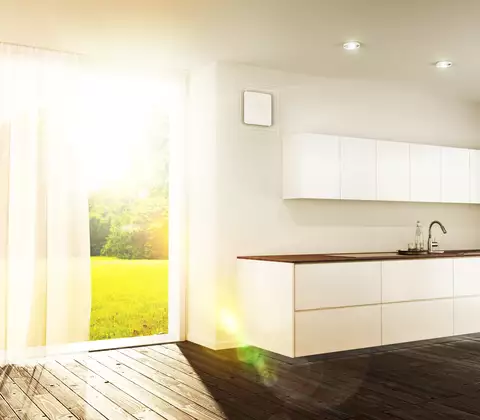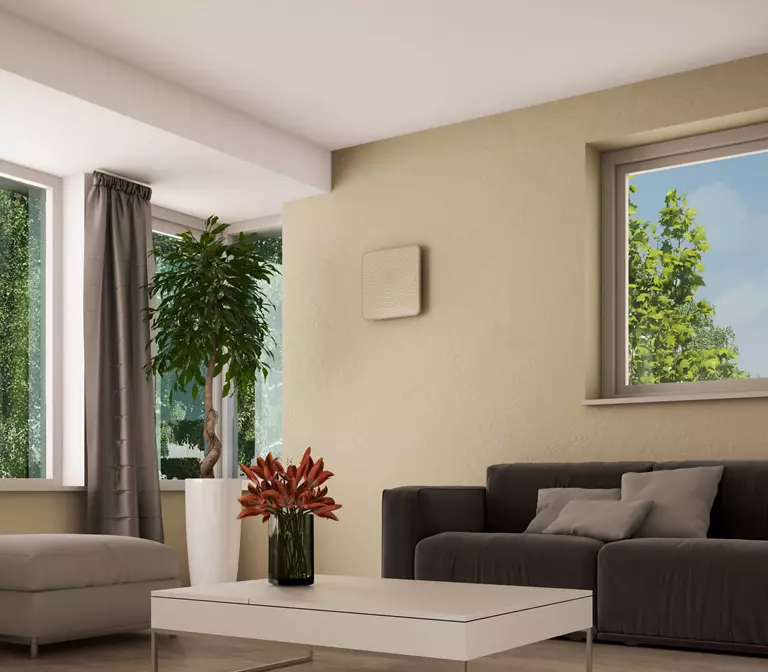If you are not concerned about having the convenience of automatic ventilation throughout the whole house, there is nothing to be said against a decentralised solution. This applies, above all, to rooms affected by particularly high humidity levels, such as bathrooms and kitchens.

Decentralised ventilation systems
Providing fresh air where needed
Decentralised ventilation systems supply individual rooms in a building with a plentiful amount of fresh air conveniently and as needed. Find out more about the benefits and various types available here.
Table of contents
To decide whether a decentralised ventilation unit meets your requirements, you need to consider not only all the benefits but also the following facts: The cost and effort of maintaining the decentralised variant is somewhat higher compared to central mechanical ventilation. After all, there are multiple filters installed in the decentralised units that have to be checked and replaced instead of a single central filter.
Furthermore, decentralised ventilation systems have lower air exchange rates, which may mean that additional units are required for multiple rooms or in large rooms. And while central ventilation supplies all the rooms of your house with fresh air, if you have a decentralised system, you still have to manually air the rooms in which no ventilator is fitted. As a result, your savings on heating costs are not as high as those provided by central mechanical ventilation.
04. Types of decentralised ventilators
Decentralised mechanical ventilation systems are available either with or without heat recovery functions.
Without heat recovery
The simplest and cheapest version of a decentralised ventilation system consists of an extract air fan that moves air from the interior to the exterior. This creates negative pressure that causes outside air to flow in automatically through a fresh air inlet. This variant does not recover any heat from the air, meaning that it does not save any heating costs.
With heat recovery
If low heating costs are important to you and you want to reduce your CO2 footprint, you should have a decentralised mechanical ventilation system with heat recovery installed. These appliances contain a heat exchanger that transfers heat from the extract air to the supply air. These variants are also more convenient than simple extract air fans as the air exchange rate is adjustable on most appliances.
Ideally, decentralised ventilation systems should contain a humidity sensor that continually adapts the output of the appliances to suit the current moisture load.

05. Checklist for decentralised ventilation systems
You should start by considering whether you want a central or decentralised ventilation system. In new buildings or if you are completely refurbishing a building, it is usually advisable to fit central mechanical ventilation. This will save you the greatest amount on heating costs. Furthermore, you can enjoy the comfort of automatic ventilation throughout the entire house and the air exchange will always be perfectly adjusted for the various rooms.
In older buildings, installing central mechanical ventilation is usually complicated so the simpler decentralised variant may be more suitable.
If you observe the following tips when buying your new decentralised ventilation system, nothing can go wrong:
When choosing a decentralised ventilation system, you should ensure that the appliance has a sufficient air exchange rate for the respective room.
The required air exchange rate can differ greatly depending on how the rooms are used. Therefore, the decentralised ventilators should have variable output rates.
Will the ventilation unit still work at -20°C? Check the unit’s operating range.
Does the appliance have an electrical preheater to protect the heat exchanger from freezing?
Noise generation is inevitable because the ventilation unit contains a fan, but there are noisy and quiet appliances available.
Modern drive motors for fans use very little electricity, but you should still compare the power consumption of the ventilation units.
If you install a ventilator in the kitchen, your extractor hood should be switched to recirculation mode.
If you have a ventilator in a living room with a wood-burning stove, the stove should ideally have a balanced flue.
If your stove has a conventional flue, a low-pressure sensor is required that will shut off the ventilation system if the pressure falls too low.
Does the cladding of the decentralised ventilation unit suit your interior design? This is also an important factor.
If you wish to retrofit a decentralised ventilation system in an existing building, you can take advantage of a state subsidy.
Funding is also available for ventilation technology in new buildings if you are planning to build an energy-efficient house.
Answers to your questions about decentralised ventilation systems
Decentralised mechanical ventilation systems with bypass functions can help to cool your home’s interior on summer nights. However, for more cooling power, a combination of a ventilation system and a heat pump with an integrated cooling function has greater cooling capacity.
A typical ventilator only needs an opening in the outside wall about 18 centimetres across. It is almost always possible to find space for such a small opening. If not, the decentralised ventilation can alternatively be installed using an opening in the roof or mounted on ceilings.

Our recommendation: The CWL-D-70 ventilation system
50 years of experience have gone into the development and design of our top seller in the residential ventilation sector.


